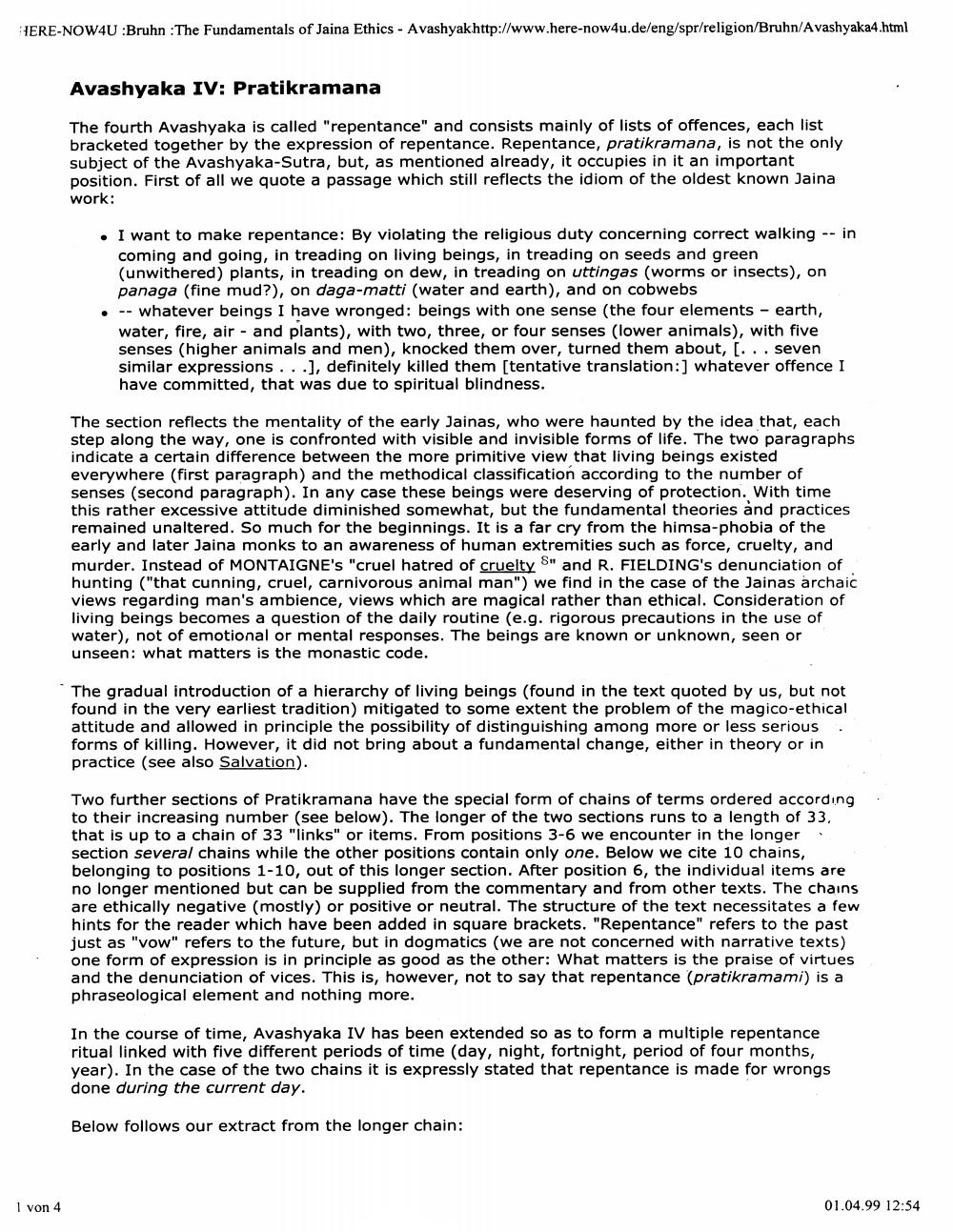________________
HERE-NOW4U:Bruhn :The Fundamentals of Jaina Ethics - Avashyak.http://www.here-now4u.de/eng/spr/religion/Bruhn/Avashyaka4.html
1 von 4
Avashyaka IV: Pratikramana
The fourth Avashyaka is called "repentance" and consists mainly of lists of offences, each list bracketed together by the expression of repentance. Repentance, pratikramana, is not the only subject of the Avashyaka-Sutra, but, as mentioned already, it occupies in it an important position. First of all we quote a passage which still reflects the idiom of the oldest known Jaina work:
⚫ I want to make repentance: By violating the religious duty concerning correct walking -- in coming and going, in treading on living beings, in treading on seeds and green (unwithered) plants, in treading on dew, in treading on uttingas (worms or insects), on panaga (fine mud?), on daga-matti (water and earth), and on cobwebs
⚫ -- whatever beings I have wronged: beings with one sense (the four elements - earth, water, fire, air and plants), with two, three, or four senses (lower animals), with five senses (higher animals and men), knocked them over, turned them about, [... seven similar expressions. . .], definitely killed them [tentative translation:] whatever offence I have committed, that was due to spiritual blindness.
The section reflects the mentality of the early Jainas, who were haunted by the idea that, each step along the way, one is confronted with visible and invisible forms of life. The two paragraphs indicate a certain difference between the more primitive view that living beings existed everywhere (first paragraph) and the methodical classification according to the number of senses (second paragraph). In any case these beings were deserving of protection. With time this rather excessive attitude diminished somewhat, but the fundamental theories and practices remained unaltered. So much for the beginnings. It is a far cry from the himsa-phobia of the early and later Jaina monks to an awareness of human extremities such as force, cruelty, and murder. Instead of MONTAIGNE's "cruel hatred of cruelty S" and R. FIELDING's denunciation of hunting ("that cunning, cruel, carnivorous animal man") we find in the case of the Jainas archaic views regarding man's ambience, views which are magical rather than ethical. Consideration of living beings becomes a question of the daily routine (e.g. rigorous precautions in the use of water), not of emotional or mental responses. The beings are known or unknown, seen or unseen: what matters is the monastic code.
The gradual introduction of a hierarchy of living beings (found in the text quoted by us, but not found in the very earliest tradition) mitigated to some extent the problem of the magico-ethical attitude and allowed in principle the possibility of distinguishing among more or less serious forms of killing. However, it did not bring about a fundamental change, either in theory or in practice (see also Salvation).
Two further sections of Pratikramana have the special form of chains of terms ordered according to their increasing number (see below). The longer of the two sections runs to a length of 33. that is up to a chain of 33 "links" or items. From positions 3-6 we encounter in the longer section several chains while the other positions contain only one. Below we cite 10 chains, belonging to positions 1-10, out of this longer section. After position 6, the individual items are no longer mentioned but can be supplied from the commentary and from other texts. The chains are ethically negative (mostly) or positive or neutral. The structure of the text necessitates a few hints for the reader which have been added in square brackets. "Repentance" refers to the past just as "vow" refers to the future, but in dogmatics (we are not concerned with narrative texts) one form of expression is in principle as good as the other: What matters is the praise of virtues and the denunciation of vices. This is, however, not to say that repentance (pratikramami) is a phraseological element and nothing more.
In the course of time, Avashyaka IV has been extended so as to form a multiple repentance ritual linked with five different periods of time (day, night, fortnight, period of four months, year). In the case of the two chains it is expressly stated that repentance is made for wrongs done during the current day.
Below follows our extract from the longer chain:
01.04.99 12:54




